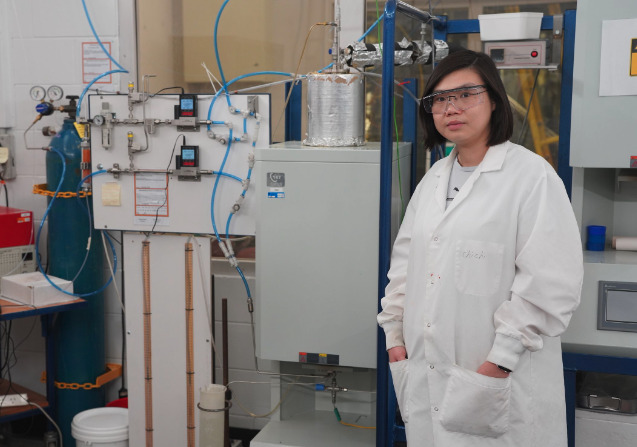University of Canterbury (UC) PhD student, Chichi Zhang, is developing technology and the relevant metal oxide materials to help produce green hydrogen from New Zealand’s abundant supply of woody biomass.
Woody biomass originates from trees including stems, branches, barks as well as forestry slash. The technology and materials developed in the project could help solve the problem of slash wood washed away from forests in heavy rain.
Together with wastes from manufacturing traditional wood products, it can be used as solid fuel for energy or converted to liquid fuels, gaseous fuels and chemicals through various technologies.
A PhD student in Chemical and Process Engineering, Zhang’s (pictured) research centres on how to convert the woody biomass into a hydrogen-rich gas product with increased hydrogen yield. The thermochemical process adopted in her research is known as chemical-looping biomass steam gasification.
“We’ve been using temperatures of up to 1000°C in the process, and by adding metal oxides, we can enhance the hydrogen yield by over 50%. These metal oxides can be used numerous times in the chemical-looping biomass process,” Zhang says.
The hydrogen-rich gas produced from the research will be further processed to convert other gases, such as carbon monoxide and methane, to hydrogen and carbon dioxide.
While the concept of this technology has been proposed in previous studies, Zhang has developed a new metal oxide that has a longer active life.
“Metal oxides are the key for developing this technology but the common issue is that their lifetime is often short, which limits the practical application if they can’t be used again,” she says.
Her project is the first part of an integrated process to produce green hydrogen from woody biomass. Eventually, the hydrogen and carbon dioxide mixture will be separated to produce pure hydrogen and pure carbon dioxide.
The latter parts of the process are being investigated by other members of UC’s research team, led by Professor Shusheng Pang, Zhang’s PhD senior supervisor.
Zhang says high purity hydrogen is a clean energy carrier, but it doesn’t exist naturally on earth.
“So, it’s important to produce green hydrogen to help curb carbon emissions. To date, the main technology to produce hydrogen is methane steam reforming but methane is not renewable.”
Her research is part of a larger research programme evaluating the overall technical, economic, and environmental performance of hydrogen production and its commercial viability.



